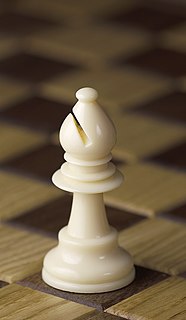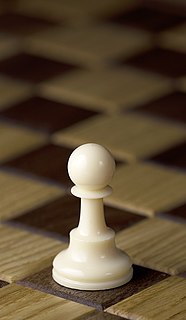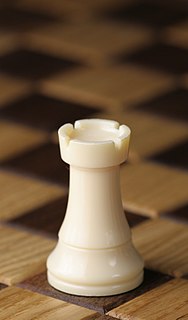Makrukpronounced [màːk rúk]), or Thai chess, is a board game that descended from the 6th-century Indian game of chaturanga or a close relative thereof, and therefore related to chess. It is regarded as the most similar living game to this common ancestor of all chess variants.

Cylinder chess is a chess variant with an unusual board. The game is played as if the board were a cylinder, with the left side of the board joined to the right side. According to Bill Wall, in 947 in a history of chess in India and Persia, the Arabic historian Ali al-Masudi described six different variants of chess, including astrological chess, circular chess and cylinder chess.

Tamerlane chess is a strategy board game related to chess and derived from chaturanga. It was developed in Persia during the reign of Timur, also called Tamerlane (1336–1405). Some sources attribute the game's invention to Timur, but this is by no means certain. Because Tamerlane chess is a larger variant of chaturanga, it is also called Shatranj Kamil or Shatranj Al-Kabir, as opposed to ash-shaghir. It is distinctive in that there are varieties of pawn, each of which promotes in its own way.
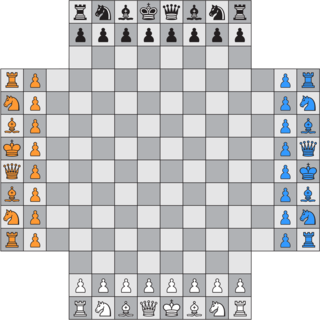
Four-player chess is a family of chess variants typically played with four people. A special board made of standard 8×8 squares with an additional 3 rows of 8 cells extending from each side is common. Four sets of differently colored pieces are needed to play these variants. Four-player chess follows the same basic rules as regular chess. There are many different rule variations; most variants, however, share the same board and similar piece setup.
Chess with different armies is a chess variant invented by Ralph Betza in 1979. Two sides use different sets of fairy pieces. There are several armies of equal strength to choose from, including the standard FIDE army. In all armies, kings and pawns are the same as in FIDE chess, but the four other pieces are different.

Minichess is a family of chess variants played with regular chess pieces and standard rules, but on a smaller board. The motivation for these variants is to make the game simpler and shorter than the standard chess. The first chess-like game implemented on a computer was a 6×6 chess variant Los Alamos chess. The low memory capacity of the early days computer required reduced board size and smaller number of pieces to make the game implementable on a computer.
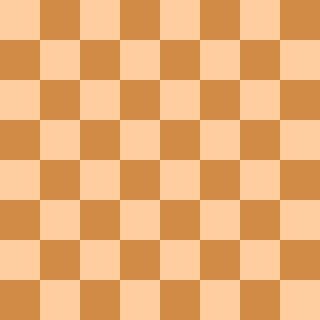
Monochromatic chess is a chess variant with unknown origin. The initial board position and all rules are the same as in regular chess, except that pieces that begin on a black square must always stay on a black square and pieces that begin on a white square must always stay on a white square. This would mean that knights can never move, but The Classified Encyclopedia of Chess Variants says that knights make a double jump. It has been suggested that a knight be replaced with a (3,1)-leaper (camel).
In the tactics and strategy in the board game of chess, an exchange (exchanging) or trade (trading) of chess pieces is series of closely related moves, typically sequential, in which the two players capture each other's pieces. Any types of pieces except the kings may possibly be exchanged, i.e. captured in an exchange, although a king can capture an opponent's piece. Either the player of the white or the black pieces may make the first capture of the other player's piece in an exchange, followed by the other player capturing a piece of the first player, often referred to as a recapture. Commonly, the word "exchange" is used when the pieces exchanged are of the same type or of about equal value, which is an even exchange. According to chess tactics, a bishop and a knight are usually of about equal value. If the values of the pieces exchanged are not equal, then the player who captures the higher value of piece(s) can be said to be up the exchange or wins the exchange, while the opponent who captures the lower value of piece(s) is down the exchange or loses the exchange. Exchanges occur very frequently in chess, in almost every game and usually multiple times per game. Exchanges are often related to the tactics or strategy in a chess game, but often simply occur over the course of a game.

The following outline is provided as an overview of and topical guide to chess:

Wildebeest Chess is a chess variant created by R. Wayne Schmittberger in 1987. The Wildebeest board is 11×10 squares. Besides the standard chess pieces, each side has two camels and one wildebeest. The inventor's intent is "to balance the number of 'riders'—pieces that move along open lines—with the number of 'leapers'—pieces that jump".

Dragonfly is a chess variant invented by Christian Freeling in 1983. There are no queens, and a captured bishop, knight, or rook becomes the property of the capturer, who may play it as his own on a turn to any open square. The board is 7×7 squares, or alternatively a 61-cell hexagon with two additional pawns per side.

Wolf Chess is a chess variant invented by Dr. Arno von Wilpert in 1943. It is played on a 10×8 chessboard and employs several fairy pieces including wolf and fox – compound pieces popular in chess variants and known by different names.

An amazon is a fairy chess piece that can move like a queen or a knight. It may thus be considered the sum of all orthodox chess pieces. It cannot jump over other pieces when moving as a queen, but may do so when moving as a knight. In diagrams in this article, the amazon is represented by an inverted rook. Chess moves in this article use A as notation for the amazon.

Chesquerque is a chess variant invented by George R. Dekle, Sr. in 1986. The game is played on a board equaling four Alquerque boards combined, and like Alquerque, pieces move along marked lines (9×9) to the points of intersection. All the standard chess pieces are present, plus one additional pawn and one archbishop fairy piece per side. The pieces move in ways specially adapted to the Alquerque-gridded board.

Tri-Chess is the name of a chess variant for three players invented by George R. Dekle, Sr. in 1986. The game is played on a board comprising 150 triangular cells. The standard chess pieces are present, minus the queens, and plus the chancellor and cardinal compound fairy pieces per side.
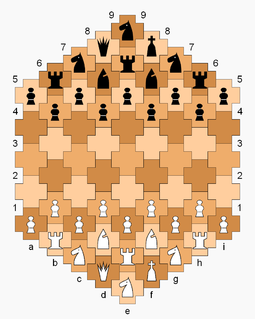
Cross Chess is a chess variant invented by George R. Dekle, Sr. in 1982. The game is played on a board comprising 61 cross-shaped cells, with players each having an extra rook, knight, and pawn in addition to the standard number of chess pieces. Pieces move in the context of a gameboard with hexagonal cells, but Cross Chess has its own definition of ranks and diagonals.

Quatrochess is a chess variant for four players invented by George R. Dekle, Sr. in 1986. The board comprises 14×14 squares minus the four central squares. Each player controls a standard set of sixteen chess pieces, and additionally nine fairy pieces. The game can be played in partnership or all-versus-all.
The camel is a fairy chess piece that moves like an elongated knight. When it moves, it can jump to a square that is three squares horizontally and one square vertically, or three squares vertically and one square horizontally, regardless of intervening pieces; thus, it is a (1,3)-leaper.

